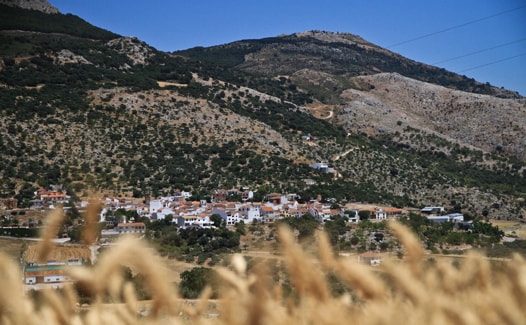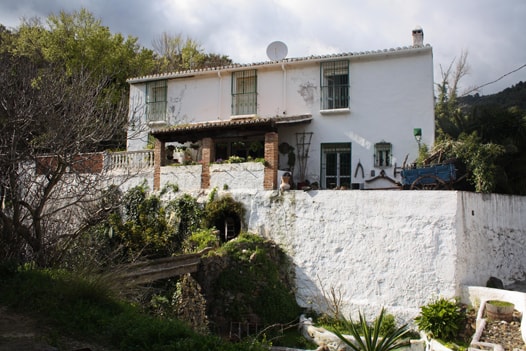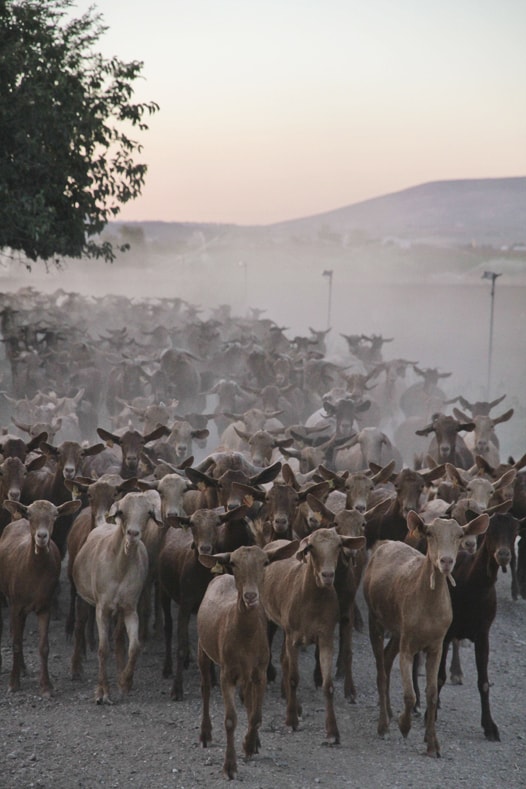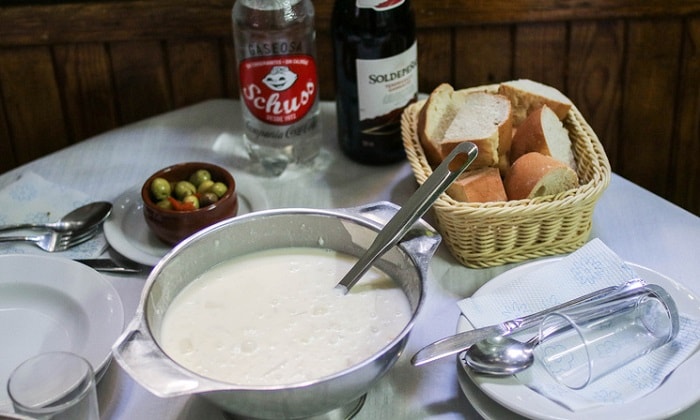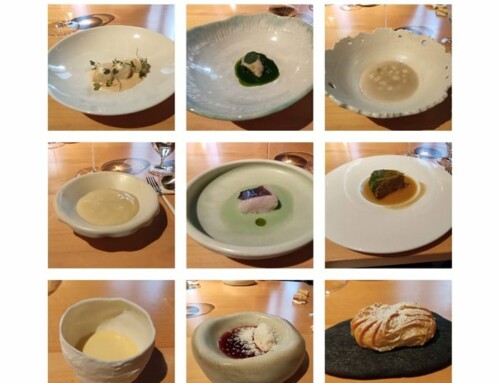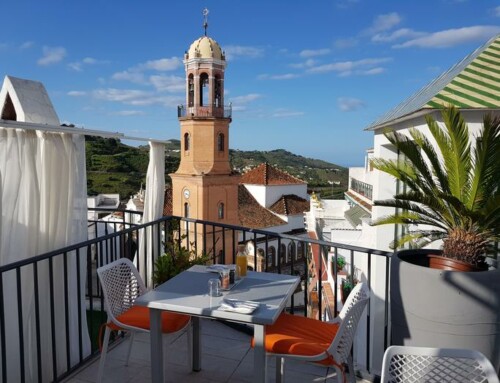The province of Malaga is much more than just sun and beach in summer. A great number of its white villages celebrate during these months unique gastronomic festivals where they put in the center of attention the product par excellence of the area: cherries from Alfarnate, peaches from Periana, ajoblanco from Almáchar or olives from Alozaina, as well as the different and always cheerful celebrations of the regional grapes, raisins and wine.
Whet your appetite, because among wheat stubbles, olive tree mosaics, Spanish broom and oleander, Spain Food Sherpas takes us on a tour through the province to discover the festive traditions of a dozen municipalities. Put on some flip flops and a hat- it will be hot.
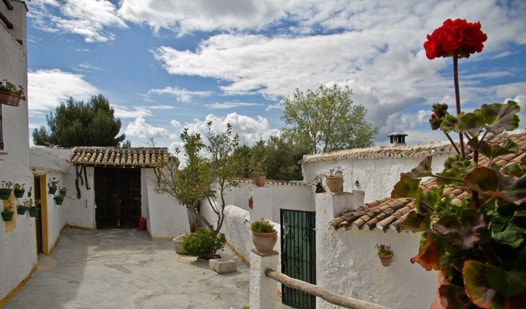 English version of the article “Rutas para comerse Málaga este verano”, written by N. Sánchez / Spain Food Sherpas for traveler.es (19/06/15).
English version of the article “Rutas para comerse Málaga este verano”, written by N. Sánchez / Spain Food Sherpas for traveler.es (19/06/15).
1. Day of the Cherry · Alfarnate
How far can you throw a cherry pit? If you are good at it, try your luck at this weekend’s competition in Alfarnate, a small village of a thousand inhabitants in Malaga. That day, the regular customers change their liquor coffee and domino routine in the La Parada bar, to see who the winner is going to be. The huesil championship takes place during the “Cherry Day”, which is held every penultimate weekend of June and which is now in its tenth edition.
Cherries are quite a newcomer in this region- just two decades ago, a couple of farmers wanted to learn more about this fruit during a course and they realized that their land was very suitable to plant cherry trees. They were excellent students: so today, fifty families copied them and the area is already known as Malaga’s “Jerte Valley”, because of its production of high quality cherries and they even say that they are bigger and juicier than the ones from Caceres.
Each year more than 600 kilos of this fruit are distributed among visitors, who last year were more than five thousand. There is music and dancing, but as well show cooking and food tastings.
In Spain Food Sherpas we highlight the “catana”, a type of porra from Antequera (cold tomato soup), the “morrete” made with potatoes and mushrooms or “papaveotes” casserole with breadcrumbs and egg as main ingredients. And “resoli”, a local preparation of liquor (aguardiente), coffee, cloves and cinnamon that will energize you to spit the cherry pit further than you have ever imagined- although a couple of drinks later, you might not even see them anymore.
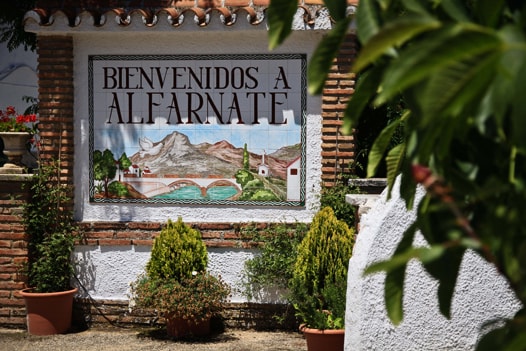
2. Day of the Peach · Periana
The conditions for growing peaches in Periana are so good, that it’s common to harvest pieces of up to half a kilo. In order to celebrate that (because in Malaga you celebrate almost everything), they hold an annual Peach Day since the 80’s, which brings together the few farmers of the village and the more than 10,000 people which come every year to enjoy this festival.
The first weekend of August becomes like this a good option to beat the heat: First, because of the gastronomy with the classic sangría where the local peach is the main protagonist; And then, with culinary proposals based on this refreshing and fleshy fruit: peach mousse, cold peach tea, peach gazpacho, peach fritters, peach jam, peach sandwiches, peach meat balls … and so on and so forth- there’s even a peach on the driving school logo.
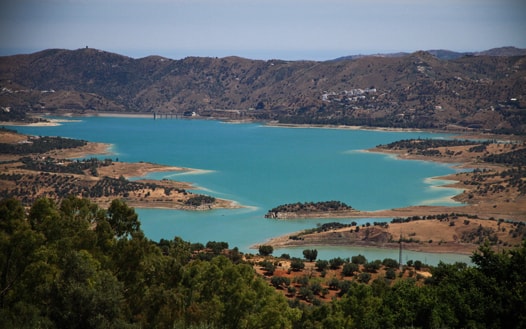
If the heat continues, and it will, you always have the option to return to the beach (just 25 kilometers away) or try water sports in La Viñuela reservoir, turquoise waters and just about six kilometers from the village.
The legend states that it was a neighbor, called El Rojo who, after visiting his family in Argentina, planted the first peach tree in Periana with a pit he brought in his pocket. So here or on any other party, have an eye on what you take with you from your visit: you just might change the economy of your village.
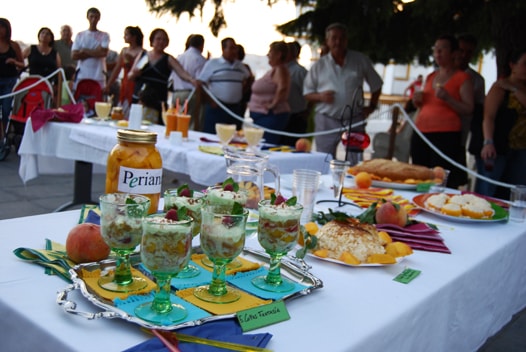
3. Gazpacho Festival · Alfarnatejo
Alfarnatejo is one of these small villages that stops before you even had a walk through them and they only have one bar: here it’s called Barroso. But it’s also one where it seems that time stood still and where strangers are looked at closely by the barley 500 inhabitants.
Except the first weekend of August, when they receive almost 3.000 people with open arms in order to celebrate one of the most typical dishes of Andalusia: the gazpacho. But forget about the common Andalusian version, because here the tradition prevails and this cold soup is made with “three hits”: one of olive oil, one hint of salt and a splash of vinegar, to which you incorporate finely chopped vegetables (tomato, cucumber, onion, pepper and mint, apart from bread of course).
This trio of three hits is always added by eye and if you had a mistake, you’ve got to start again; but the neighbors from this locality (called “tejones”) never fail, as you can see in the Gazpacho Festival.
In recent years the Flamenco Soiree of the Southern Pyrenees is also organized there, which belongs to the area of the Axarquía that is full of cliffs and gorges, with peaks of about 1,500 meters that surround the valley. A superb venue for hiking and loosing yourself, just like the bandits that were the protagonists of local legends for a long time.
4. Day of the Muscat Grape · Iznate
In August the families of Iznate go to the countryside. But not on vacation, but to work: it’s time to start picking grapes and to dry them later on to obtain the prized local raisins. Before leaving the second weekend of August, the whole town gathers to celebrate the Day of the Muscat Grape.
The neighbors bring their best dishes made with local produce and create an exquisite and homemade culinary route coordinated by the so called Council of Butlers that ensures that no one repeats recipes. “Hornazos” (meat pie), fried pumpkin with blood sausage, gazpacho colorao, ajoblanco (garlic soup), pipirrana or cateta salad are some of the proposals.
And, as recommended by Spain Food Sherpas, they also serve “baticate”– a delicacy in form of a milkshake made with avocado, banana and cinnamon, invented in the nearby town of Benamargosa.
In addition, three tons of Muscat grapes are distributed among the more than 5,000 visitors that come each year to Iznate. And everything enlivened with “Verdiales” music, also known as mountain punk. At the end of the day you choose Miss Muscat among the young people of the village and you celebrate a traditional open-air dance (verbena) that runs until dawn.
5. Wine Night · Cómpeta
In Cómpeta it’s almost easier to hear English or German than Spanish: 40 percent of its 3,000 inhabitants are foreigners. But urban growth has not stopped this beautiful town from keeping its roots. It proofs so every August 15th: on that day, several grape harvester dressed in traditional clothing come in procession to the Grape Harvest Square at noon with the Verdiales soundtrack.
There they deposit the grapes for their traditional grape treading, which are then collected in “capachas” and pressed again with a wooden beam to extract the juice. The scene depicts the preparation of Muscat wine for which this town is famous for.
The province of Malaga is much more than just sun and beach in summer. A great number of its white villages celebrate during these months unique gastronomic festivals.
It also serves as the starting signal for the Cómpeta Wine Night that begins this day with the pressing of the grapes and tasting of classic “flour crumbs” or “migas” (cooked in huge pans with an enormous amount of oil) accompanied with cod, arriera salad and of course grapes and muscatel wine, of which 1,500 liters are served.
As quickly as the sweet wine goes to your head, the festival will easily last until the night between craft stalls and local cuisine with an absolute focus on the Muscat grape, which they say is sweeter than honey itself.
The celebration has a religious part as well- to honor the patron saint of Cómpeta so that the vintage is successful- but it was made since always to dismiss the grape harvester at the beginning of the summer season.
That it’s called Wine Night is thanks to Aurelio Fernandez, a “competeño” back in 1973, who invited his neighbors to drink all the Muscat wine they could during one night. The collective hangover must have been tremendous, but this tradition was very well accepted and here they go for the 40th edition.
6. Ajoblanco Festival · Almáchar
In the 60’s, when tourism was starting on the Costa del Sol with Torremolinos as its maximum exponent, the eastern province of Malaga felt a little forgotten. Even more the inland municipalities like Almáchar, who had difficult access.
Actually, in a straight line it’s only 20 kilometers away from the capital, but by car you have to drive three times that far due to the horseshoe curves and dirt roads. So one day the neighbors invited some politicians to get to know the village and to probably suffer the journey, in order to fully understand their demands.
With the intention to convince them, they regaled them with their traditional “ajoblanco” or refreshing white garlic soup. And they must have liked it, because three years later they managed to build a road of about 30 kilometers from Malaga to Almachar.
Since then, the neighbors decided to keep this ajoblanco festival every first Saturday of September and it’s going for its 50th anniversary, being the pioneer of Malaga’s gastronomic celebrations.
The ajoblanco is one of the most recommended products from Malaga by Spain Food Sherpas. It is made of almonds, garlic and bread, olive oil, vinegar and salt. More than 3,000 liters are distributed during this important day of Almáchar, which is usually served in earthenware pitchers (botijos) along with Muscat grapes of the area.
And if you’ve been able to withstand the hot day, you can always finish it with the typical popular verbena. Watch out when you return: the curves of the road make you wonder if the politicians of the 60’s rewarded or punished the “almachareños” for their demand. Check it out.
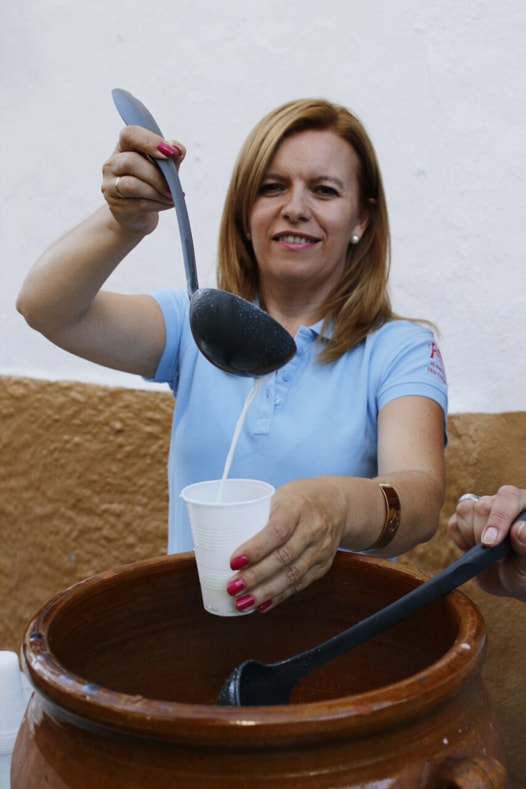
7. Day of the Raisin · El Borge
From late August or early September on (depending on the weather) the neighbors of El Borge leave their houses to then sit on their doorsteps or bulrush chairs, to patiently separate each raisin from the bunch, maintaining the stalk, so that the fruit is being well preserved.
This task is called “picada” and requires a lot of time, partly because this city is the one with most hectares dedicated to the cultivation of raisins throughout Spain. In El Borge they are made the old fashioned, traditional way: with the sun as the only additive during the 20 days of the drying process, where they are spread over the floor on the “paseros”– those white triangles and rectangles that characterize the landscape of the Axarquía area.
After a first selection, the best raisins are chosen. All of this contributes that they have their own Designation of Origin (Denominación de Origen).
The demonstration of the process can be seen every third Sunday of September, the Day of the Raisin. A festival in which you can also learn how the “arriera” vintage is still practiced there: mules that transport the grape bunches in saddlebags from the vineyards located on the steep slopes.
There are also tastings of traditional dishes like gazpacho, cold cuts and a huge pan of crumbs (migas), as big as an attempt to supply the 10,000 people who can spend this day in El Borge. A huge opportunity to sell some raisins in wooden boxes called “catites”, with its stalk to keep the memory. Or not?
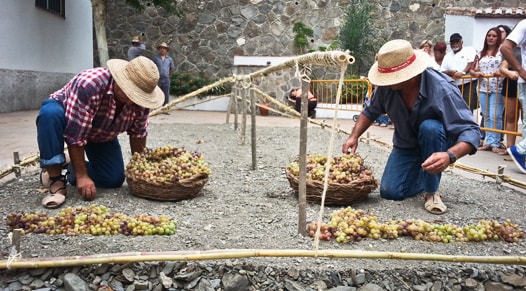
8. Olive Festival · Alozaina
For the almost 2,000 inhabitants of Alozaina, the arrival of September is even harder than for the rest of the mortals. Not only does it mean the end of summer, but also the beginning of the olive harvest, the verdeo, a physically tiring and important work, because the olives are taken one by one from the tree and each one can easily have 2,000.
At least they have a double consolation: The first one, because they are responsible for collecting the only olive with a Designation of Origin of Spain, the aloreña olive, characterized by its floating pit that separates easily from the fruit; And the second- before they work they have time to party on the Day of the Olive.
A celebration of this town in the Sierra de las Nieves that is always held around the 12th of September, when they cherish the Virgin Mary, whose image is carried throughout the town on the shoulders of women.
This festive day dates from the beginning of the century, but at that time it was devoted to cattle, until in the 90’s they opted for the olive that is much more representative of this area and its people. And they went from sack races and mantecado ice cream tastings to an olive dressing contest which is more than recommended by Spain Food Sherpas, apart from the usual music performances. In the night it turns into a kind of feria in the town’s square where you give everything, before jumping into the olive field.
9. “Malagueña” Goat Festival · Casabermeja
It is one of the more recent gastronomic festivals. It takes place in Casabermeja and is celebrated on the third weekend of September, probably because it was of the only remaining one without a traditional festival during summer. It is dedicated to the goat from Malaga, a native breed that is among the world’s best dairy goats.
Cheeses, sausages and pâtés are made with it, and the famous young goat, which many would not eat if they knew exactly what they were savoring.
During what will be the seventh edition of this Goat Festival of Casabermeja, there are passacaglia, donkey rides, cultural visits, handmade cheeses workshops, cattle shows and demonstrations of the traditional dance the “bermejos” call “churripampas”.
Also a tapas competition and the possibility to taste a wide range of dishes made with local meat and milk: from roasted young goat to a grilled goat cheese salad, to liver with onions, young goat pastoral style, goat chops and desserts like pasiegos, custard or rice pudding- always with goat milk, naturally.
10. Vintage Festival · Mollina
If Antonio Nadal, Rafael Alberti, Antonio Gala, Fernando Quiñones, José M. Caballero Bonald, Luis Garcia Montero, Espido Freire and Rosa Regas have anything in common, in addition to their passion for literature, it’s having announced at some point the Harvest Festival of Mollina.
The event celebrates the end of the grape harvest, focusing on the town’s most precious treasure: the wine that is marketed with the Designation of Origin “Málaga” and “Sierras de Málaga” (like the delicious Botani wine).
A horse race or a mass bike ride through the village are only some of the additional activities of this folk festival that lives for its wine and whose paired wine tastings with local produce are a success year after year.
Obviously, it couldn’t be otherwise, it brings together the entire northern region of the province of Malaga, which at this time of the year enjoys participating in any activity like this, in order to make the most of the last days of summer: soon autumn will come.
Did we whet your appetite? All these local products can be found in the Atarazanas Foof Market. We love this market so much that we feature it on our Malaga Tapas Tour and our Cooking Classes and we are proud to approach them to more and more people every year.
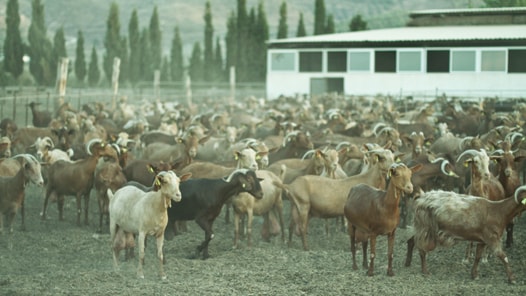
SIGN UP FOR OUR NEWSLETTER!
Don’t forget to share this post!
Related Articles
↓
Sign up for our Newsletter and get the inside scoop on our favorite recipes,
exploring and devouring Spain and more.
